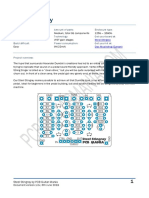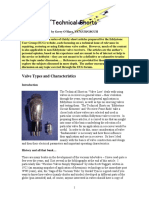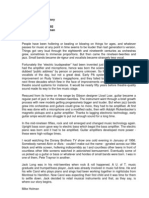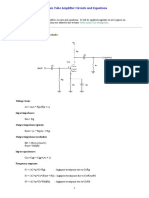The Big Muff π Page
The Big Muff π Page
Uploaded by
Robbyana 'oby' SudrajatCopyright:
Available Formats
The Big Muff π Page
The Big Muff π Page
Uploaded by
Robbyana 'oby' SudrajatCopyright
Available Formats
Share this document
Did you find this document useful?
Is this content inappropriate?
Copyright:
Available Formats
The Big Muff π Page
The Big Muff π Page
Uploaded by
Robbyana 'oby' SudrajatCopyright:
Available Formats
The Big Muff
Page
The Definitive Big Muff Resource and History VISIT MY SWORDS, KNIVES and FANTASY ART WEBSITE www.kitrae.net THE BIG MUFF CIRCUIT - How it Works Here is a simple primer about the workings inside the Big Muff Pi circuit. The BMP circuit is based on a common amplifier design with clipping diode/feedback loops. Clipping stages in amplifier circuits were nothing new to the effect pedal world when the Big Muff was created back in 1969/70, but what makes the Big Muff's circuit unique are two nearly identical clipping sections in a row, one clipping an already distorted signal, and subtle changes in capacitor and resistor values to smooth out and tame that signal as it goes through the mayhem of those two stages. The typical BMP circuit is made up of 46 components: 4 transistors, 22 resistors, 13 capacitors, 4 diodes, and 3 potentiometers. The circuit is built in five stages: an input/gain stage, first clipping stage, second clipping stage, a tone stage, and output stage. The input stage is a simple amplifier that sets the gain for the circuit and filters some highs and lows. The first clipping stage softly clips the waveform in a feedback loop, creates the distortion, and filters and compresses the signal. The distortion is still rather weak, so second clipping stage repeats and refines the distorted signal even more, creating what EHX calls the "violin like sustain" Big Muffs are known for. These two cascading soft clipping stages combine to create a hard clip, and function similarly to how cascading drive stages in tube amplifiers work. In the tone section the signal splits apart into a high pass and a low pass filter, which are each then blended back together with the tone potentiometer. One end of the pot rotation is mostly low pass signal and one end is mostly high pass. There is some bandwidth and gain lost in the tone section signal blend, which creates the mid range notch, or "scoop". The output stage recovers the gain lost in the tone stage. CIRCUIT GUIDE - Without getting into too much detail, below is a simple Big Muff Circuit Guide using a typical version 1 and version 2 Big Muff PCB trace, with stages broken out by color, and a schematic with explanations of some of the individual section functions. The colors shown on the circuit photos match the corresponding colored sections on the Circuit Guide schematic. Keep in mind that my notes about how the individual components affect the circuit are a rather simplistic guide. Changing a value in one stage affects the circuit in other areas. There is a give and take each time something is changed, a very complex interaction, so experimentation is key to altering or creating a Big Muff circuit to get the most desirable sound. Using this may help with an undertsanding of why one particular vintage or modern Big Muff may sound better/worse/different than another, or in creating or modifying your own circuit. CLICK ON AN IMAGE TO ENLARGE
VERSION 1 AND VERSION 2 BIG MUFF CIRCUIT BOARDS - Below are pictures of typical V1 and V2 circuits with stages broken down by color. Below that are the part list numbers for all components that populate the circuits. Note that the V1 and V2 circuit boards both follow an identical circuit pathway, only the layout shape is different. Also note that the component values
for the V1 and V2 Big Muff circuit boards shown below each have identical component values that match the Circuit Guide schematic (shown above) for easy identification of the part locations in the circuit, but real vintage Big Muffs rarely have identical component values. The part numbers on the PCB layout drawing belwo also correspond to the part numbers on the Circuit Guide. R stands for resistor, C for capacitor, and Q for transistor. The particular circuits shown below are negative ground, but vintage BMPs were made with both PNP and NPN transistors. There is no real affect on the sound either way.
...
KEY TONE COMPONENTS - If you study the various vintage Big Muff Pi circuits and schematics on this website you will find a very wide variety of components values used from circuit to circuit, even among circuits in the same enclosure. Spread across thirty-five caps and resistors, it may seem mind boggling to keep up with how each of these these may affect the sound, but looking at the circuit architecture, only a few of these have a major impact on the tone. The rest can have values that vary slightly and not influence the tone in any great way. The ones I have found that make the most difference in sculpting out unique tone differences are the Feedback/Filter Caps, Clipping/Blocking Caps, and the Tone Stack Filters. These define what makess one version different from another.
Clipping / Blocking Caps - These two caps determine the bandwidth to be clipped by the diodes in the two Clipping Stages, and have the most affect on the sound of the Big Muff. Typically they are identical in each stage, though I have seen many examples of V1 and V2 Muffs where the cap in the first stage was smaller than the second. When both caps are identical, smaller values remove more high frequencies, increasing bass, and larger values remove more low frequencies, decreasing bass. This has the effect of determining if a Big Muff will sound huge boomy/bassy, or less bassy/chunky. When the cap in one clipping stage is different from the other, the difference is not as great as when both are changed. A BMP with .12uF in the first and 1.0uF in the second will sound in between one with two .12uF caps, or two 1.0uF caps.
V1 (Triangle) Big Muffs were made with .05uF, .1uF, .12uF, and 1.0uF clipping caps, giving a wide variety of bass response from unit to unit. You will find the same range on the Guild Foxey Lady version. Similarly, V2 Big Muffs in the larger (Rams Head) enclosure were made with .047uF, .1uF, .12uF, and 1.0uF clipping caps. That is one reason why there is not really a definable difference in a Ram's Head Big Muff and a Triangle, other than the enclosure. They both spanned the same wide range of possible sounds. You will find the same range on the Guild Foxey Lady version. Russian Big Muffs always had .047uF clipping caps, which is why they sound so smooth and bassy/boomy. The V9 reissue uses 1.0uF and the modern Little Big Muff uses .1uF. Feedback / Filter Caps - These three caps usually have identical values to each other in any given Big Muff circuit. They are responsible for how fizzy/buzzy a Big Muff will sound. Essentially they filter the amount of high frequencies in the bandwidth, determining if a Muff will sound more on the smooth side or the harsh side. In conjunction with the Clipping Caps, they can make the bottom end sound hollow and bassy, or thick and chunky. Larger values roll off more highs and smaller values give more crunch and buzz to the sound. The better sounding vintage Big Muffs tend to have the larger values and sound smoother and warmer. Modern Big Muffs tend to have the lower values and sound a bit more buzzy/fuzzy. Most V1 (Triangle) Big Muffs commonly have 500pF or 560pF caps, though some had 470pF. You will find the same range on the Guild Foxey Lady version. Later Big Muffs in the larger V2 (Ram's Head) enclosure ranged from 470pF, 500pF, 560pF, and even 680pF caps, though most had 470pF or 560pF. Both Ram's Head and Triangle Big Muffs spanned essentially the same wide range of possible sounds. You will find the same range on the Guild Foxey Lady version. Russian Big Muffs ranged from 430pF on early models, to 500pF(the Civil War model) to 470pF on later green and black versions. The modern V9 reissues and the Little Big Muff use 470pF. Tone Stack Filters - Big Muffs are known for their trademark mids scooped tones, meaning the mid frequencies are removed from the bandwidth, making the sound very deep and dark. Some Big Muffs are more mids scooped than others, and the frequency of the scoop may be higher or lower in the bandwidth. The less scooped, the brighter the Muff sounds and more easily it will stand out in a band mix with the bass guitar and other instruments that may occupy the same frequencies. The more mids scooped, the deeper and darker the tone sounds. Two filter resistors in the tone stage determine the amount of mids that are scooped, or removed. The high pass resistor (22k in the example above) determines the midrange notch. Higher values have less mids scooped out and lower values have more mids scooped. This resistor also works in conjunction with the high pass tone capacitor (.0004uF in the example above) to affect the treble at low tone
settings. Reducing this cap to .003uF alters the range and scoops slightly more mids. Increasing to .004uF reduces the scoop. Combined, a larger high pass cap and smaller resistor decreases the treble at low tone settings. The low pass resistor (39k in the example above) works in conjunction with the low pass filter cap (.01uF in the example above) to also affect the treble at low settings. A smaller cap and larger resistor will also reduce the treble at low tone settings. In V1 (Triangle) Big Muffs the high pass resistor values range from 22k, 27k, 33k, 39k, and 47k, with 22k and 33k being the most common. You will find the same range on the Guild Foxey Lady version. In V2 (Rams Head) Big Muffs the high pass ranges from 22k, 33k, and a few odd 39k. 33k was by far the most common for V2s. Overall Traingle and Ram's Head Big Muffs spanned the same range of possible tones. You will find the same range on the Guild Foxey Lady version. Russian Big Muffs almost always used a 22k high pass resistors, creating heavy but smooth bass with the mids scoop frequency boosted a bit. The modern V9 reissue also used 22k, and later 27k high pass resistors. The modern Little Big Muff and Bass Big Muff use 22k. In V1 (Triangle) Big Muffs the low pass resistor values range from 22k, 33k, and 39k, with 33k being the most common. In V2 (Rams Head) Big Muffs the low pass resistors ranged equally from 33k to 39k. Essentailly the same range as Triangles. Russian Big Muffs almost always used a 20k low pass resistors, changing to a 22k for the last black boxed Russian version. The modern V9 reissue Big Muff used 22k, 39k, and later 27k low pass resistors. The modern Little Big Muff uses 22k, and the Bass Big Muff uses a 11.5k low pass resistors. THANKS and OTHER DISCUSSIONS OF THE CIRCUIT - Thanks go to Robert P., Jansen, and Matt for assistance. Thanks to Jack Orman for his writings explaining the BMP circuit in his excellent Big Muff and Rat eBook, which got me started many years ago. That took me from barely knowing how or why any components in a circuit do what they do, to still barely knowing, but having a grasp on what they are affecting in this circuit. I also learned a lot from the old ampage.org forum discussions. Below are a few other good discussions of the circuit. Feel free to pass along any others you may come across if you think they would be of interest, or let me know of dead links. My email addy is back on the home page. The Large Beaver - A Walkthrough - Very good explanation of every stage of the Big Muff, in the form of the BYOC Large Beaver. I highly recommend anyone interested in building a vintage Muff clone start with this kit, and if you want to see what changes in component values do first hand, socket everything so you can trade out components on the fly.
Technology of the Big Muff - What Does What? - Thanks to RP for alerting me to this thread on the DIY forum. A thread started by John Lyons with lots of good details and discussion of the circuit. Big Muff Pi Mods and Tweaks - A slection of some of the more popular mods. Determining the Gain Factor of a Big Muff - A good article from the Big Muff Schematics, Articles, and Modifications website. Calculate the Gain of the Big Muff Stages - Another good thread from DIY about BMP gain BIG MUFF TRANSISTORS AND OTHER COMPONENTS - Is There Mojo in Vintage Components? COMPONENT VALUES MAKE THE SOUND - Some Big Muff enthusiasts think one particular transistor type over another determines if one Muff will sound better, worse, or different than another. It is actually the mix of different values of all of the components in the circuit (capacitors, resistors, diodes), and the transistor values that make one Muff sound better or different than another. The signature Muff sound comes from the two diode clipping sections in a row in the four stage transistor amplifier design. Past that, the real tonal differences are from the mix of the individual component values. The older the Muff, the more those values seem to be different from one unit to another, and the newer the Muff, the more they are the same from unit to unit. These differences are what give each Muff its own unique character. TRANSISTOR HYPE ? - There is a lot of hype about certain transistors that are desirable in vintage Big Muffs. On the top of this list is the mysterious FS36999 transistor found in vintage V1 and V2 Muffs. Transistors have a gain measurement, called hFE. Technically it is a measurement of the forward current gain ratio in DC current transistors. The F stands for forward and E means the transistor connection is in emitter mode. One transistor type may have higher or lower hFE than another, and those values can vary greatly among the transistors of the same type. This gain should really not affect the circuit much because the bias for the amount of gain the pedal will have is set by the resistors coming from the collector and emitter of each transistor, but it does seem to have an affect on certain aspects of the tone. Too high and it can be aggressively bright and sometimes too fuzzy, too low and it may not have enough gain/sustain for the clipping sections to work properly and may be weak or dark sounding. Lower gain tranys can also be smoother sounding than higher gain ones, and higher gain tranys can influence the mids and pick response. There are other characteristics as well, like clarity, raspiness, thickness, and volume. Those characteristics can vary from transistor manufacturer to manufacturer, and vary between older and newer tranys of the same type. These effects are usually minimal, but they are there. That is why many of the boutique makers screen batches of transistors to weed out the less desirable ones. Electro-Harmonix never screened transistors when they made the original Big Muffs. That may account for some of the wide variety of different sounding Muffs of the same model, but that variety really comes from the large variance in other component types and values from unit to unit. I suggest not getting too hung up on the transistor type when looking for a vintage Muff though. A Muff with old 2n5088 or BC239 tranys may sound just as good, or bad, as one with old 2N5133, FS3700, or the much revered FS36999 tranys. The other circuit
components are just as important to the tone. If you have never opened your vintage Muff up to look at the transistors on the PCB, here are INSTRUCTIONS for taking one apart.
..
..
..
Shown on left: A vinatge V1 Big Muff circuit with ceramic capacitors, carbon composition resistors, and FS36999 Silicon transistors. Shown on right are two other vintage Silicon transistors used in Big Muffs, the 2N5087 and BC239 VINTAGE COMPONENT MOJO - Some Big Muff enthusiasts argue that a particular set of component values (1uF clipping caps vs. 0.1uF caps, for example) give a Big Muff the best sound, but that is subjective based on the sound one person prefers that another may not. Some also think there is mojo in the old vintage components that make those Muffs sound much better than more recent issues (old ceramic caps vs new film caps, or old 2N5133 tranys vs newer 2N5088 tranys, for example), and I would tend to agree with that, as most of the Muffs I like best are the older ones. However, I have played vintage Muffs side by side with exact clones made using modern components and the sound is very close. I'm not saying the mojo is not there in the older Muffs. It can be, and is in my opinion, but you can get one vintage Big Muff that sounds great and another that sounds average, with the exact same components. If you want a decent vintage Big Muff tone you don't necessarily need to fork over hundreds of dollars to buy a vintage one, hoping you get a good sounding unit, when you can spend under two hundred dollars and get a vintage Big Muff clone like the BYOC Large Beaver, or a Stomp Under Foot, all made with modern parts that are more consistant than most vintage parts.
...........................
Shown above (left to right): A vintage 1973 Big Muff and the Brick Muff replica made by Stomp Under Foot for the Big Muff Classic series, using all modern components. The Brick was Big Muff Classic #4. The custom graphics were added by me using Gerald Scarfe's wonderful artwork created for Pink Floyd's The Wall. THE '73 BIG MUFF VERSUS THE '73 S.U.F. CLONE TEST - Here is an experiment I did with one of my favorite vintage Big Muffs, a V2 "Ram's Head" Big Muff with 1973 pot dates (shown above), FS36999 transistors, polyester film caps, and all carbon comp resistors. Matt at Stomp Under Foot made an exact clone of this in 2010, the "Brick Muff", for his Big Muff Classic Series. It was based on my circuit trace of the original. It was made using modern carbon comp resistors, ceramic caps, and 2N5088 transistors. Matt is well known in the Big Muff community for making very accurate, high quality clones of just about every model or popular schematic of the various vintage Big Muffs, many of the-spin off vintage Big Muff variants, and his own unique Big Muff type pedals. Here are sound clips comparing the original '73 BM to the Brick Muff, with the volume, tone, and sustain matched as close as possible. In each clip, the '73 Big Muff is first and the Brick is second. Played with a Fender Strat loaded with a Seymour Duncan SSL-5 bridge pickup and Fender CS '69 neck pickup into a Reeves Custom 50 (Hiwatt Custom 50 replica) with Vintage Purple "Fane" replica speakers. Tone Pot Comparison Comparison with Chords and Rhythm Comparison with Leads/Solos Comparison of solos 1 - with Demeter Compulator (compressor), Boss CE-2 chorus (modulation), and Carbon Copy (delay echo) Comparison of solos 2 - David Gilmour style solos with Compulator, CE-2, Carbon Copy
Do they sound the same to you? They are different, but the differences are minor. There is a bit more fuzz in the bass notes with the SUF pedal, and a slightly different feel to the clarity of the fuzz. The original is slightly tighter in the bass. The differences are more noticable when using modulation, as these filters can bring up frequencies that are not as noticable without. There is also a slightly different feel between the two when playing. However, overall I feel these two pedals sound and play 90% the same. Is that extra 10% the vintage mojo? Perhaps. It could also be that the component values in the vintage Muff have slightly changed over time as the materials decayed, giving some parts a slightly different tolerance than what they are labeled. Those values marked on the vintage components may be unreliable as well, and the tolerances between the older parts and the newer may also account for the slight difference. I suspect that if each component value were individually removed from the circuit, measured, and exactly matched (they were not), these two pedals would sound even closer. But still, the similarity is incredibly close considering these two pedals were crafted with components made around 37 years apart! Not long after this demo, I replaced the 5088 transistors in the SUF clone with a set of high hFE Fairchild SE4010 transistors. These seemed to get the clarity slightly closer to matching the original FS36999 transistors in the 1973 Big Muff (though most 4010 tranys are actually very low hFE). I was also able to test a set of vintage 2N5133 (thanks to Darrin) transistors with hFEs in the 800s against the modern SE4010s and 2N5088 transistors. Based on my experience with these in vintage Big Muffs, I thought for sure that the 2N5133 tranys would make a much more noticable difference. Surprisingly, there was not much difference, but the Big Muff sounded slightly better with the modern 2N5088s. The difference is hard to put my finger on, but it is in the clarity of notes I hear when playing solos, and the tightness of the fuzz in low notes. The high gain 4010s I have are also different in this manner, but the differences are so minor between these three types that most people would probably not even pick up on it. I think the majority of the tone signature is really determined by the key cap and resistor values, NOT by the transitor type. The caps in the Big Muff clipping sections seem to control most of the tonal characteristics, not the transistors, unless the hFEs are too low. Low gain transistors can drastically affect the tone and clarity, but the ones I tested were all high gain, above 400 HFE. Poor quality transistors can also affect how noisy the pedal will be. VINTAGE VS. NEW - Modern Electro-Harmonix Big Muff pedals and custom "boutique" versions of the Big Muff circuit like the Blackout Effectors Musket or Skreddy Pig Mine are all made with modern components. They sound very different from eachother, and very different from vintage E-H Big Muffs. What sounds "good" all depends on the individual - what tone you are looking for or what tone you prefer, as well as the guitar ans amp used.. Some people dislike the current E-H Big Muffs, citing that the old ones simply sound far superior. They do sound different, but that is because E-H is always changing the circuit with each new version so it WILL sound different. This is sort of a tradition with each new Big Muff model made. Does that mean the new Muffs sound inferior? Again it is all a matter of preference. The "older is better" thought does not hold up when you look at reliability of old components versus new, but many prefer the older tones simply because they are not common with modern Muffs. I also suspect there is occasionally some feeling of superiority from someone who paid $500-$1000 for a vintage Big Muff which causes that person to talk negatively about the newer Muffs, which typically sell for under $100. Regardless, which one a person likes is really just a matter of
individual taste. David Gilmour of Pink Floyd made his vintage Ram's Head Big Muffs, as well as his modern Pete Cornish made Big Muff clones and variants, sound incredibly fluid and melodic, and unlike any other guitarist. In a totally different style of music, someone like Jack White of the White Stripes makes fantastic, raw, and raunchy distorted guitar tones, simply using a modern USA reissue Big Muff. I think both eras sound different, but equally great. BIG MUFF REPLACEMENT PARTS Here are INSTRUCTIONS for disassembling a vintage Big Muff.
REPLACEMENT POTS - Vintage USA Big Muffs (V1, V2, V3) have single-gang, linear taper, 24mm,100k potentiomers. Electro-Harmonix used pots from various makers, but they were usually the 24mm size, with 1/4" D shaped knob shafts. Logarithmic taper pots, or "audio" pots, will also work and are more fine tunable, but they are more expensive than linear. The difference between linear and logarothmic/audio pot types is that linear increases (electrical resistance) evenly as you turn the knob, whereas log has a shorter increase at both ends of the knob rotation, but a longer, increase in the middle. That that wider spectrum in the middle means a more usable range to allow better fine tuning with a log pot. Both types sound the same, but the knobs will be in different positions for the same volume, tone, or gain level. A Something to keep in mind, some pots are letter coded with A or B to represent linear or logarithmic, but there is no worldwide standard for which is which. In general, the USA standard, which I believe came from Japan, is A=log/audio and B= linear. The European standard is A=linear and B=log/audio. For example, a USA made pot may be marked B100k, with means 100k linear taper. A100k would meAn 100k logarithmic/audio taper.
V4 and V5 op-amp Big Muffs were made with 130k linear taper Sustain and Tone pots. The Volume pot was 150k linear. Later V4 and V5 Muffs had all 150k linear pots. V6 Big Muffs tended to have all 150k linear taper pots. V9 Big Muffs had varied pots, with some using all 100k linear pots, and some using 500k logarithmic volume pots. Russian made Big Muffs have Russian made pots, usually 100k linear taper. You can use 100k audio log taper for the volume and sustain pots. Electro-Harmonix used both at various times. They have also used 150k pots. Replacements could be found at Small Bear Electronics at the time this article was written. If you replace an old pot with a new one of the same size, it is sometimes hard to find pots with the same pot shafts that fit the old knobs. You can pull the shafts out of the old pots and install them in the new ones. For vintage USA Big Muffs, carefully bend back the four tabs on the top/back of the casing on the old pot, slide the casing off, then remove then shaft. Open the new pot this same way and install the old shaft. Be very careful not to damage the internal tracks. Small Bear Electronics carried Big Muff replacement pots at the time this article was written, but many other electronics suppliers carry them as well. REPLACEMENT SCREWS - Vintage and modern large box USA Big Muff enclosure screws can be replaced with 4x3/8" pan head phillips screws found at most large hardware stores. For older Russian Big Muffs, use metric screws. The original innner enclosure lid scrws for large box Russian Big Muffs were Sovtek 1590NS, 1790NS. The outer box screws were Sovtek 1290NS. Both could be found at Small Bear Electronics at the time this article was written. REPLACEMENT KNOBS - There were many knob types used on V1 and V2 vintage USA Big Muffs. Unfortunately, these are no longer in production. I have not even had any luck finding
anything similar, so I resorted to taking Silicon rubber molds of some of my knobs and casting resin copies as replacement for missing knobs in my collection. For original V1 Big Muff replacement knobs, try Davies Molding #1550. Not the same, but approximately the same size. V2/3/4/5 Muffs all used Daka Ware style pointer knobs. They are still being made by Davies Molding at the time I write this (2011) and can be found online, Davies #1470. The large Hockey puck shaped knobs on V5/V6 and modern V9 Big Muffs and the smaller hocky puck style knobs used on the Little Big Muff are made by Electro-Harmonix. OEM replacements for those can be found at Small Bear Electronics. Pedal Parts Plus also carries replacement knobs that can be used. Note that most vintage Big Muffs had D shaped posts, so D shaped post holes or knobs with round holes and a set screw are necessary. Remove your knobs to see which type you have. Old Russian Big Muff knobs are not available anywhere. The black plastic pointer knobs used on some of the last small box Russian Big Muffs are still made by Davies Molding and can be found online. Small Bear Electronics and Pedal Parts Plus carry a range of replacement knobs that can be used. RUSSIAN BIG MUFF BATTERY DOORS - Small Bear Electronics was selling the metal green Russian Big Muff battery doors online for a time. There are no plastic doors available for replacement of the early Russian made Big Muffs. I have used a piece of aluminum or steel sheet metal, folded and cut to size with wire cutters as a substitue for the plastic doors. REPLACEMENT SLIDE SWITCHES - Power and tone bypass switches on vintage USA Big Muffs are Alpha Slide DPDT 90 size. Small Bear Electronics carries Big muff replacement switches. REPLACEMENT JACKS - In general, the input jack is stereo and the output jacks is mono. 1/4" size Switchcraft or Neutrik jacks can be used as replacements. Switchcraft #11 or Neutrik #NYS229 can be used for the mono jack, and Switchcraft #12B or Neutrik #NYS230 can be used for the stereo jack. Small Bear Electronics or Pedal Parts Plus carry jacks. Replacement Russian Big Muff jacks and plastic jack nuts could be found at Small Bear Electronics at the time this article was written. REPLACEMENT FOOT SWITCHES - Vintage USA Big Muffs use old Carling SPDT (Single Pole Double Through) three lug foot switches. These are sometimes hard to find. The modern Carling model is #112-P, or you can get a Dunlop version, #ECB-69, often used for Crybaby Wah pedals. When replacing a foot switch, I suggest using a modern 3PDT foot switch instead and wire your pedal for true bypass. The large foot switches used on the older large box Russian Big Muffs are no longer available. Replace with similar SPDT or 3PDT switch as above. Since the enclosure hole is so much larger, you must attach a small metal plate over the hole and drill a smaller hole in it to accommodate the small switch. Small Bear Electronics or Pedal Parts Plus carry switches.
You might also like
- Bd2-Brent Mason-ModDocument8 pagesBd2-Brent Mason-ModНиколай ПрокопенкоNo ratings yet
- Gcu 10 Manual en PDFDocument11 pagesGcu 10 Manual en PDFChhoan Nhun100% (1)
- 1b Static & Dynamic Characteristics&Loading Effect PDFDocument45 pages1b Static & Dynamic Characteristics&Loading Effect PDFvishnu100% (1)
- CS3 Mods PDFDocument6 pagesCS3 Mods PDFAnonymous LgJH9UE2jNo ratings yet
- Fuchs Ods ManualDocument16 pagesFuchs Ods ManualSrdjan StefanovNo ratings yet
- Torsepc 5001TCP Manual 09'29'2003Document18 pagesTorsepc 5001TCP Manual 09'29'2003mahh1234100% (2)
- TheGigRig What Is A BufferDocument3 pagesTheGigRig What Is A BufferRicaTheSick100% (1)
- Schematics (Rev 2)Document11 pagesSchematics (Rev 2)Charles Austin100% (1)
- MUFF GUTS - The Big Muff Circuit, Wiring Diagrams, Schematics, Replacement PartsDocument7 pagesMUFF GUTS - The Big Muff Circuit, Wiring Diagrams, Schematics, Replacement PartsgianmarcoNo ratings yet
- The British Amp Invasion: How Marshall, Hiwatt, Vox and More Changed the Sound of MusicFrom EverandThe British Amp Invasion: How Marshall, Hiwatt, Vox and More Changed the Sound of MusicNo ratings yet
- Dumb Le NotesDocument7 pagesDumb Le NotesFrank Puchi100% (1)
- Tales From The Tone Lounge - The Ultimate JCM800Document7 pagesTales From The Tone Lounge - The Ultimate JCM800JivReyNo ratings yet
- Steel Stingray Building DocsDocument7 pagesSteel Stingray Building DocsMembelah DiriNo ratings yet
- True Bypass To Big MuffDocument8 pagesTrue Bypass To Big MuffJuan Ignacio SalvucciNo ratings yet
- Hot-Rodding The New Fender Champion 600 - 300guitars ComDocument4 pagesHot-Rodding The New Fender Champion 600 - 300guitars CommaradonagolNo ratings yet
- Valve Types and Characteristics With AppendixDocument30 pagesValve Types and Characteristics With AppendixJoãoAraújoNo ratings yet
- Twimble 17 OrigDocument2 pagesTwimble 17 Origomadameletis11No ratings yet
- U Boot V15Document4 pagesU Boot V15Mattia Terri TerrandoNo ratings yet
- JVM410 MODS ListDocument5 pagesJVM410 MODS ListAndrés López ToroNo ratings yet
- The Fender TBX Tone Control Mod, Part 2Document2 pagesThe Fender TBX Tone Control Mod, Part 2ScrbertoNo ratings yet
- 15R Manual - Pathfinder15 - 15R - EFGJ1Document3 pages15R Manual - Pathfinder15 - 15R - EFGJ1ravegg1No ratings yet
- How To Bias A Tube AmplifierDocument35 pagesHow To Bias A Tube AmplifierEdgarNo ratings yet
- MXR Distortion + Analysis: Table of ContentsDocument14 pagesMXR Distortion + Analysis: Table of ContentsgianmarcoNo ratings yet
- Keeley Super Overdrive SD-1: Recommended Starting PointsDocument1 pageKeeley Super Overdrive SD-1: Recommended Starting Pointsalguifarro100% (1)
- 1 Humbucker - 1 Volume 3 Way Mini-Toggle: Series/Split/Parallel SwitchDocument1 page1 Humbucker - 1 Volume 3 Way Mini-Toggle: Series/Split/Parallel SwitchGülbahar100% (1)
- Princeton 65 ManualDocument4 pagesPrinceton 65 ManualJames BashamNo ratings yet
- Treble Bleed Mods: Normal Volume Pot Wiring Wiring With Treble Bleed CapDocument3 pagesTreble Bleed Mods: Normal Volume Pot Wiring Wiring With Treble Bleed Capokr15No ratings yet
- 2011 Fender Super-Sonic Brochure PDFDocument16 pages2011 Fender Super-Sonic Brochure PDFJFGuitarsNo ratings yet
- Audio Distortion MeasurementsDocument20 pagesAudio Distortion MeasurementsAntonioPalloneNo ratings yet
- Fractal AmpDocument41 pagesFractal AmpAbdielSerrano100% (1)
- Single Pickups How To Make A Humbucker Out of TwoDocument3 pagesSingle Pickups How To Make A Humbucker Out of TwoCj JingcoNo ratings yet
- Simulation of A Guitar Ampli Er StageDocument10 pagesSimulation of A Guitar Ampli Er StagexychenNo ratings yet
- Marshall (Informaciã N Tã©cnica)Document23 pagesMarshall (Informaciã N Tã©cnica)Jose Luthier De Amplis GuitarrerosNo ratings yet
- Service Manual Guitar Amplifier Night Train 15C1 NT15C1: Assembly View: 2 Schematic Diagram: 3 Test Mode: 7 Parts List: 8Document9 pagesService Manual Guitar Amplifier Night Train 15C1 NT15C1: Assembly View: 2 Schematic Diagram: 3 Test Mode: 7 Parts List: 8FouquetNo ratings yet
- Pro Reverb Fender Amps, Mods, Modifications, Vintage, Maintenance, Tubes, Speakers, Schematics, Blackface, Silverface, Jens MosbergvikDocument16 pagesPro Reverb Fender Amps, Mods, Modifications, Vintage, Maintenance, Tubes, Speakers, Schematics, Blackface, Silverface, Jens MosbergvikAlessandro Pasqual100% (1)
- Analisis de Circuito Big MuffDocument10 pagesAnalisis de Circuito Big MuffNacho ConsolaniNo ratings yet
- Universal Active/Passive Bass Preamp System: - UNI-PRE 3 KnobDocument13 pagesUniversal Active/Passive Bass Preamp System: - UNI-PRE 3 KnobJorge VasquezNo ratings yet
- SD1 Keeley Five Star SDDocument3 pagesSD1 Keeley Five Star SDGustavo Thomas100% (1)
- Baxandall NegativeFeedbackToneDocument7 pagesBaxandall NegativeFeedbackTonemichaelbrenden100% (1)
- Owner's Manual: FZ-5 - e1.fm 1 ページ 2006年12月12日 火曜日 午前11時39分Document20 pagesOwner's Manual: FZ-5 - e1.fm 1 ページ 2006年12月12日 火曜日 午前11時39分Marcos SOsaNo ratings yet
- Common Gain StageDocument37 pagesCommon Gain StageVincent ClaesNo ratings yet
- Amp Designer Cheat SheetDocument26 pagesAmp Designer Cheat SheetRohit BharadwajNo ratings yet
- Boss OD1 ModificationDocument2 pagesBoss OD1 ModificationIlya FuksmanNo ratings yet
- Sovtek 5881 Wxt/6L6 WGC Tube GuideDocument8 pagesSovtek 5881 Wxt/6L6 WGC Tube GuideKon GekasNo ratings yet
- Yorkville HistoryDocument57 pagesYorkville HistoryAntonioPalloneNo ratings yet
- Vibro-King Service Manual: Custom Shop SeriesDocument9 pagesVibro-King Service Manual: Custom Shop SeriesThomas MaierNo ratings yet
- Seymour Duncan How To Pick A Pickup The Factors That Affect Your Guitar ToneDocument4 pagesSeymour Duncan How To Pick A Pickup The Factors That Affect Your Guitar ToneJulio C. Ortiz Mesias100% (1)
- TrainwreckexpressDocument14 pagesTrainwreckexpressRick AutryNo ratings yet
- Electronique - Audio - Amplifier Vacuum Tube Circuits and EquationsDocument7 pagesElectronique - Audio - Amplifier Vacuum Tube Circuits and EquationskoukihamedNo ratings yet
- MaxAmp 11/45 Manual and SchematicDocument23 pagesMaxAmp 11/45 Manual and Schematicoldradioguy2100% (1)
- STM 800 BuildDocument17 pagesSTM 800 BuildKevin Montañez Huaman0% (1)
- Amp ScrapbookDocument10 pagesAmp Scrapbookarturxox1zNo ratings yet
- Steel String Singer - COLGANDocument1 pageSteel String Singer - COLGANdisse_detiNo ratings yet
- Crate Blue Voodoo 120HB ManualDocument12 pagesCrate Blue Voodoo 120HB Manualleft4dead1No ratings yet
- Tubeprimerandselection320 1Document89 pagesTubeprimerandselection320 1Leonardo RodriguesNo ratings yet
- Manual Tone Hammer v1.2Document4 pagesManual Tone Hammer v1.2cova no1No ratings yet
- The Gretsch Electric Guitar Book: 60 Years of White Falcons, 6120s, Jets, Gents and MoreFrom EverandThe Gretsch Electric Guitar Book: 60 Years of White Falcons, 6120s, Jets, Gents and MoreNo ratings yet
- The Story of Paul Bigsby: The Father of the Modern Electric Solid Body GuitarFrom EverandThe Story of Paul Bigsby: The Father of the Modern Electric Solid Body GuitarNo ratings yet
- Active Hi-Fi LoudspeakersDocument17 pagesActive Hi-Fi LoudspeakersCarioquenhoNo ratings yet
- Var It One PaperDocument15 pagesVar It One PaperDavid RJ BrownNo ratings yet
- Simple Mods For StompboxesDocument4 pagesSimple Mods For StompboxesCarlos Ramirez100% (1)
- Boss BD-2 ModsDocument1 pageBoss BD-2 ModsDjRafael TsunamiNo ratings yet
- Randall Catalog 2006Document28 pagesRandall Catalog 2006Walter Luna FrancoNo ratings yet
- Microwave - Assignment 1Document2 pagesMicrowave - Assignment 1lim hyNo ratings yet
- CD LabDocument4 pagesCD LabLOUKILkarimNo ratings yet
- ICMEMIS2017 IPS03 02 CameraReadyDocument4 pagesICMEMIS2017 IPS03 02 CameraReadyanak gondrongNo ratings yet
- MN8010 Design GuidelinesDocument11 pagesMN8010 Design GuidelineslahyouhNo ratings yet
- ADAS1000Document80 pagesADAS1000Serhii SerikovNo ratings yet
- HMC 960Document20 pagesHMC 960Kenan TiroNo ratings yet
- Sensors 20 00851 v2 PDFDocument12 pagesSensors 20 00851 v2 PDFsalemNo ratings yet
- Certification of Engineering Calculation 2: I-FormDocument69 pagesCertification of Engineering Calculation 2: I-FormParantap RahaNo ratings yet
- BLF8G10LS-270V BLF8G10LS-270GV: 1. Product ProfileDocument17 pagesBLF8G10LS-270V BLF8G10LS-270GV: 1. Product ProfileadibienNo ratings yet
- In40001 Dioda DatasheetDocument4 pagesIn40001 Dioda DatasheetIvan JmePhotographyNo ratings yet
- Day 2 - Q2 - Module 4 Radio Waves and MicrowavesDocument70 pagesDay 2 - Q2 - Module 4 Radio Waves and MicrowavesMarilyn Castro LaquindanumNo ratings yet
- Datasheet TDA 8358JDocument20 pagesDatasheet TDA 8358JJose BenavidesNo ratings yet
- Powering Large Scale NetworkDocument8 pagesPowering Large Scale NetworksshytiNo ratings yet
- UNIT-5: 1: Explain About Storage Oscilloscope With Block Diagram?Document13 pagesUNIT-5: 1: Explain About Storage Oscilloscope With Block Diagram?Sumarani KpNo ratings yet
- Electric Wheel EW200Document16 pagesElectric Wheel EW200Jarek KlamannNo ratings yet
- Final ProjectDocument27 pagesFinal ProjectMohit KeshriNo ratings yet
- Eee Syllabus, HstuDocument41 pagesEee Syllabus, HstuLikhan Kumar SahaNo ratings yet
- Mason IRE 1953Document13 pagesMason IRE 1953meifiusNo ratings yet
- MC3361BPDocument5 pagesMC3361BPtonymathew03No ratings yet
- NTE990 Integrated Circuit Dual Audio Power Amplifier: DescriptionDocument3 pagesNTE990 Integrated Circuit Dual Audio Power Amplifier: DescriptionDirson Volmir WilligNo ratings yet
- Residential & Commercial GeneratorsDocument16 pagesResidential & Commercial GeneratorsthecodekingNo ratings yet
- Integrated High Power PoE-PD Interface & DC-DC Converter ControllerDocument18 pagesIntegrated High Power PoE-PD Interface & DC-DC Converter ControllerArun PadmanabhanNo ratings yet
- 7 Chapter 6 PDFDocument60 pages7 Chapter 6 PDFHadush KingNo ratings yet
- Agilent LNA Design NoteDocument62 pagesAgilent LNA Design NotejrmciNo ratings yet
- Gương Dòng TH Đ NG Và Tích C CDocument45 pagesGương Dòng TH Đ NG Và Tích C Cngoc an nguyenNo ratings yet
- A Virtual Analog Computer For Your DesktopDocument7 pagesA Virtual Analog Computer For Your DesktoposcarNo ratings yet
- Module-1 BJT Biasing and Small Signal Operation and Models NotesDocument24 pagesModule-1 BJT Biasing and Small Signal Operation and Models NotesNisha Kotyan G RNo ratings yet

























































































